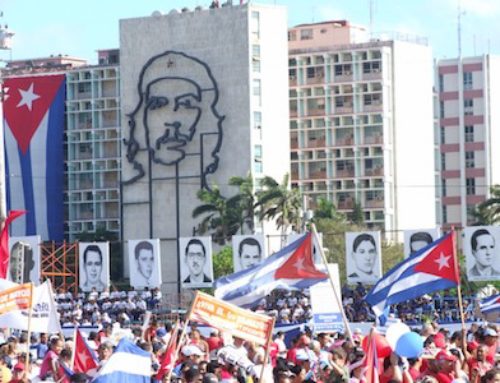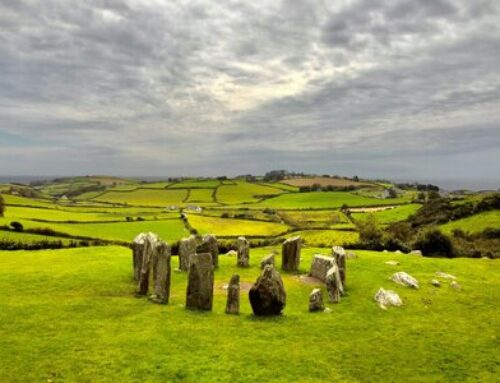British Californian Yogi Mary Paffard has been traveling to Cuba since 1998, working to train teachers, grow the Cuban yoga movement, and develop a practice that’s rooted in cross-cultural exchange. From February 7-13, 2019, she’ll be supporting a Cuban ¡Yoga Va! group and working with AltruVistas to create “Yoga is Solidarity: Dissolving Blockades Through Yoga.” Join us in Cuba for this special 20+-year anniversary trip, which will be an extraordinary journey into yoga, diversity, activism, cultural exchange, and community building. Program details can be found here, and again at the bottom of the interview.
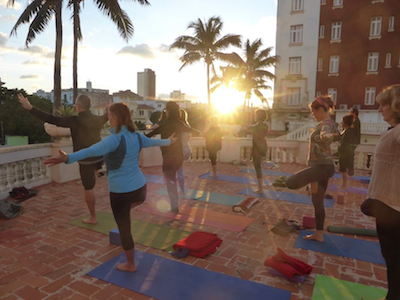
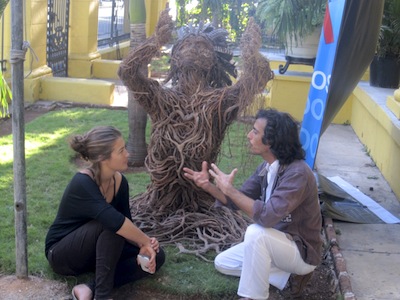

Hi Mary! Can you tell us how you started traveling to Cuba, and about the original 1999 event “Lifting the Embargo on Our Hearts”?
My friend Marta Mahou from Madrid was in Cuba in the ’90s, teaching yoga to some of her students in the diplomatic corps. In the mid-’90s, during the Special Period in Cuba, Marta encouraged me to work with a nascent yoga community in Havana, since I was geographically closer. I didn’t know much about Cuba at the time. In 1998, I was on a family holiday in Mexico, and after a few days lounging on the beach, we thought, “Well, there must be something more interesting to do!” So I got in touch with Eduardo Pimentel, the head of the Cuban Yoga Association, and went to Cuba for a week and taught a few classes. Eduardo asked me if I’d be interested in helping the US-based Black Yoga Teachers’ Alliance make a conference happen, as they had also just been in Cuba. I got involved, working alongside other teachers such as Purusha Hickson and Krishna Kaur. The ambitious goal was to get 1000 people down there and “Lift the Embargo on Our Hearts.” We invited well-known teachers to come—Rama Jyoti Vernon, Chuck Miller, Marty Ezraty, Chris Hoskins, Konda Mason—plus we were working in conjunction with Cuban teachers (though there weren’t yet many well-known Cuban teachers at that point). We also focused on cultural exchanges and events. Malia Everette was in charge of Global Exchange’s Cuba programs at that time, and she coordinated everything with the Black Yoga Teachers Alliance and with different organizations in Havana. “Lifting the Embargo on Our Hearts” was five days and four nights, with classes all day, local food, and cultural events. 350 Cubans attended, along with 100 internationals. I worked in the background, helping as I could.
Now, twenty years later, I’ve lost count of how many times I’ve been back. Maybe thirty or forty times. I realized the best way to help was to work with the small group of teachers that were emerging in Cuba at the dawn of the 21st century, so that’s what I did. Most of the original teachers Eduardo trained were men; eventually, Eduardo created a women’s training. The year after the original event, we created an organization, Cuba US Yoga Exchange, and I went down with Rodney Yee, Baxter Bell, and Jason Crandell, and we worked intensively with the teachers.
Since then the name of our group has changed several times for various political and cultural reasons, but the connection to this extraordinary hub of yoga in Cuba has continued to evolve. We are now completing our second 675-hour teacher training program, ¡Yoga Va 2!, this time under the direction of Havana’s Jorge Avila, with a faculty that includes Cuban, Central American, and US teachers. The teacher training programs we run in Cuba offer certification through Yoga Alliance, and we are in the process of certifying 16 new young yoga teachers who will be working to bring the February event together with AltruVistas.
Since 2004, we’ve also been working on the east coast of Cuba, in Holguin, as there was less access to yoga education there than in Havana. We continue to be inspired by our Cuban yoga colleagues and their practice, and we’ve continued to offer international trips, creating solidarity through mixing yoga events with cultural exchange. We have created libraries, supported media communications, translated many educational materials, and are in the process of working with Cuban yogis on a book.
What would you say the impact has been?
By the early 2000s, Eduardo said there were at least 10,000 yoga students in the Havana area alone; as of 2016, that number had doubled to 20,000. We’ve kept coming back as a kind of international injection of yoga brotherhood, and we’ve also worked with the traditional and alternative medicine groups that were often our sponsors in the early days, as well as with medical faculty in Holguin. Meditation is also blossoming in 21st-century Cuba, and there are regular conferences with speakers from all over the world. We ran a Vipassana meditation retreat in 2007 at the Faculty of Medical Science in Holguin with well-known teacher and author Christina Feldman, and in 2017, we held another retreat for the ¡Yoga Va2! group with Narayan Liebenson.
¡Yoga Va Latino! sees this interaction and story as an exchange. Yoga in Cuba is a serious practice, due in part to sociopolitical conditions. In Cuba, yoga can’t be an exclusive, narcissistic practice that shelters you from the realities. It has to be integrated with everyday life. So for many of us internationals, that deep level of practice is very inspiring. Also inspiring is the Cuban cultural arts milieu, as well as the emerging movement styles based in deeply Cuban sensibilities. Our job is not to impose a Western, colonial style form of yoga, but to evolve a conversation that connects with Cuban culture, and see what arises.
¡Yoga Va Latino! (and its previous organizational namesakes) have also worked to involve more US Latino communities in yoga. For example, in the mid-2000s, we ran the grant-funded “Mama y Yo” program in Mendocino County: a bilingual yoga education program where we taught Latina mothers while their kids were offered free childcare. We’ve assisted emerging yoga communities in Costa Rica and Mexico with courses and trainings, and we are in the process of supporting the registration of a yoga school in Argentina. ¡Yoga Va Latino! looks forward to the day when we can once again bring Cuban teachers here to the US to inspire our Latino communities (and all of us!). We support the ever-more-vibrant Latino Yoga world via events like the February delegation in order to bring us into a broader community, and to develop richer perspectives on this ancient practice.
To coincide with the February event, ¡Yoga Va Latino! is developing a fund for future international education and exchange in the names of two of the teachers who were part of the original events and trainings: Odorico Dieguez and Elio Kindelan.
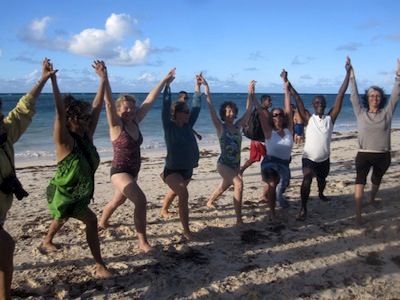
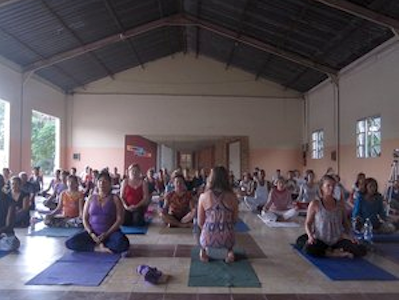
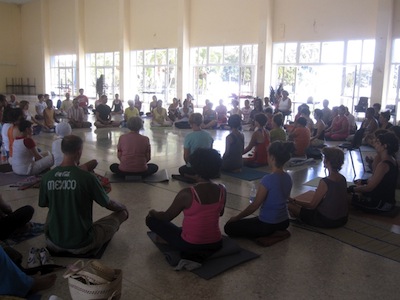
What can participants expect during the February 7-13, 2019 journey?
The February event is about seeing yoga in all its glorious Technicolor. It’s about dissolving inner boundaries and blocks, and it’s about dissolving outer blocks and bringing us together. The entire trip will be Bilingual English/Spanish. We’ll have an international flavor: participants will be there from Central America, Costa Rica, Spain, England, Canada, the US, and beyond. Each day we’ll be doing yoga in different iconic places in Havana: Sun salutes on the Malecon, evening chanting at the statue of El Cristo, a flash yoga event in an old Havana square.
We’ve also uniquely structured the trip around the five elements. Each day is based on an element and corresponding concept. Each day is another petal on the bloom of yoga.
Day 1 is Yoga is Earth/Story. We’ll learn the stories of Havana, and of yoga in Cuba.
Day 2 is Yoga is Water/Art. We’ll explore the extraordinary cross-fertilization between the arts and yoga, and spend the afternoon in the Fabrica de Arte. We’ll talk about art and yoga as generators of new ideas, of new solutions to old problems.
Day 3 is Yoga is Fire/Healing. We’ll talk about Ayurveda, as well as mental health and public health projects in Cuba. There will be presentations on community service.
Day 4 is Yoga is Air/Solidarity. This is our big celebration of yoga right outside the empty US Embassy. Our conversations will be about diversity, activism, and community building in yoga.
Day 5 is Yoga is Ether or Space/Planetary. Ecological and climate crises bring us all together. We’re reuniting ourselves so that we look after the planet together. We’ll be learning about Cuban eco-projects.
Well-known teachers who have been part of this 20+-year history in Cuba will be bringing their students and colleagues. We’ll have a mix of international teachers and Cuban teachers. Every day there’ll be a morning meditation, a basic morning class, a more advanced late-morning workshop, and Yoga Charla (conversation) with some of the interesting people in Cuban yoga. Our conferences and presentations will include talks on diversity, unity, medical and Ayurvedic connections, and teacher training methods. We’ll have a full Ayurvedic meal. We’ll discuss ecology and visit an organic farm, viewing the body of the earth as our body, not separate. We’ll ask, “What supports the evolution of a good yoga teacher in these times?”
Can you talk more about the connection you see between yoga and politics—as well as offer more information on the US embargo and how it is directly affecting the communities you work with?
This trip is definitely rooted in the current political climate. While travel to Cuba remains 100% legal and safe, the recent moves made by Trump, the barrage of conservative media against Cuba as a place to visit, and the preexisting blockade all inform our solidarity delegation. More money is moving around Cuba these days but your everyday Cuban is not benefiting from that. This year has been an economic decline.
I remember December 14, 2017—San Lazaro or Saint Lazarus’ Day, when Raul spoke to Obama. It was a magical moment. Things did improve, and a sense of possibility grew and was acted upon. A lot of that has been taken back now. Most people survive in Cuba because they have some connection to the tourist industry. That has been severely depleted since the Trump administration’s restrictions.
In terms of what I can tell you about the embargo: Any machine like an airplane—if there’s one bolt that’s made in a certain country, the country’s going to be penalized if they sell Cubans that bolt. Look for instance at the tragic recent plane crash: an ancient plane from another country. A lot of the transport systems belong to the heyday of the USSR: you still see crumbling Ladas driving around, along with the many old Chevys that are kept alive for survival and for the tourist trade. The effects of the embargo are visible not only in transport, but in food. People are trying to force vegetables to be ready sooner than they are by using chemicals because the food supply is so pressured now. Food costs are high, but food quality in general is down—even though there’s a big organic counter-movement. Internet has improved, but is behind the times, and massively expensive—though cellular technology is evolving faster and faster. There’s such a weariness around the blockade. At the children’s hospital in Havana that I visited in the past, there weren’t enough basic supplies like IV drips. There’s no basic chemo—it’s all drugs donated by countries like Switzerland, but they’re usually past their expiration date. Extraordinary Cuban medical research takes place, and the country depends on that international income, yet there’s still a tremendous struggle to receive needed medical supplies. The irony is that Cubans train and export doctors all over the world, since the country offers free training as long as the doctor will work two years in an underserved area elsewhere on the globe.
These are the conditions that inform Cuban yogis’ practice, and we must consider them and also feel into them when we join together in solidarity and citizen diplomacy.
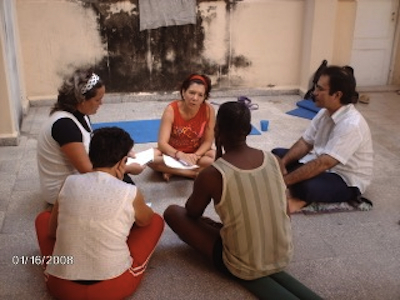
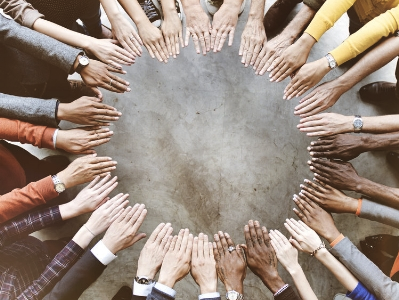
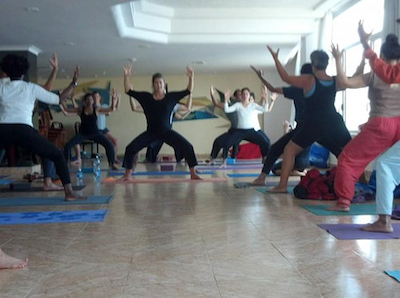
The International Day of Yoga is June 21. Can you talk about what it means to you, and about the benefit classes people can attend worldwide for ¡Yoga Va Latino! that day?
The International Day of Yoga was set up a few years ago by the UN to celebrate yoga. The Indian government instrumental in moving it forward.
¡Yoga Va Latino! sees June 21 as a perfect day to support less-well-known and less-funded yoga communities. Classes are being offered to raise funds for ¡Yoga Va Latino!. The full class list is on our site at yogavalatino.org/international-day-of-yoga-june-21/.
In these times when there’s so much strife and fear of each other, these kinds of events are incredibly important. The opportunity to come together and do something collectively and wish each other well—I think that’s huge.
Doing even a little bit of yoga with other people makes you feel better; more altruistic, more connected. By making it official, by doing it on that date or that week, the power and benefit is amplified, and there’s more opportunity for ridiculous barriers to dissolve.
I love this quote from Pablo Neruda:
With a single life,
I will not learn enough.
With the light of other lives,
many lives will live in my song.
Visit Mary on the web at www.maryyoga.com
Visit ¡Yoga Va Latino! at www.yogavalatino.org
Cuba

Feb. 7-13, 2019
$$2375 double occupancy 4-star hotels; $660 single supplement
$1990 double occupancy casas particulares; $240 single supplement
Sponsoring Organization: Mary Paffard Yoga and ¡Yoga Va Latino!
Availability: OPEN

